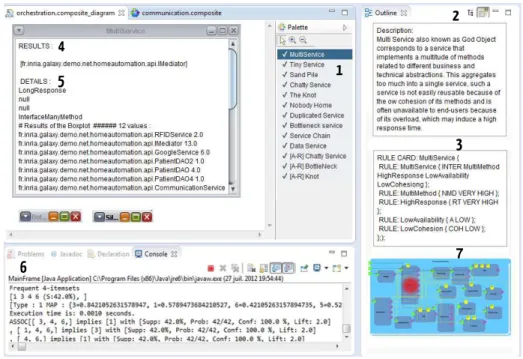of SOA Antipatterns
Mathieu Nayrolles
1,2, Francis Palma
2,3, Naouel Moha
2, and Yann-Ga¨ el Gu´ eh´ eneuc
31
CESI.eXia, ´ Ecole Sup´ erieur d’Informatique, France mathieu.nayrolles@viacesi.fr
2
D´ epartement d’Informatique, Universit´ e du Qu´ ebec ` a Montr´ eal, Canada moha.naouel@uqam.ca
3
Ptidej Team, DGIGL, ´ Ecole Polytechnique de Montr´ eal, Canada {francis.palma,yann-gael.gueheneuc}@polymtl.ca
Abstract. During their evolution, Service Based Systems (SBSs) need to fit new user requirements and execution contexts. The resulting changes from the evolution of SBSs may degrade their design and Quality of Service (QoS), and thus may cause the appearance of common poor solutions, called Antipatterns . Like other complex systems, antipatterns in SBSs may hinder the future maintenance and evolution. Therefore, the automatic detection of such antipatterns is an important task for assessing the design and QoS of SBSs, to facilitate their maintenance and evolution. However, despite of their importance, no tool support exists for the detection of antipatterns in SBSs. In this paper, we intro- duce a prototype tool, called Soda , for detecting SOA (Service Oriented Architecture) antipatterns in SBSs.
Keywords: Antipatterns, Service Based Systems, Detection, Specifica- tion, Quality of Service.
1 Introduction
Service Based Systems (SBSs) evolve to fit new user requirements, e.g., addi- tional functionalities or better Quality of Service (QoS). These technical and functional changes may degrade the design and QoS of SBSs and often intro- duce poor solutions, called Antipatterns , by opposition to patterns which are good solutions to recurring problems. Multi Service and Tiny Service are two common and recurring antipatterns in SBSs, and it is revealed, in particular, that Tiny Service is the root cause of many SOA failures [4]. Multi Service is an SOA antipattern that corresponds to a service that implements a multitude of methods related to different business and technical abstractions. Such a ser- vice is not easily reusable because of the low cohesion of its methods and is often unavailable to end-users [1]. Conversely, Tiny Service is a small service with just a few methods, which only implements part of an abstraction. Such service often requires several coupled services to be used together, resulting in
A. Ghose et al. (Eds.): ICSOC 2012, LNCS 7759, pp. 451–455, 2013.
c Springer-Verlag Berlin Heidelberg 2013
higher development complexity and reduced usability [1]. While degrading the design and QoS of SBSs, antipatterns may make it harder for engineers to per- form maintenance and evolution tasks. SOA antipatterns are more dynamic in nature, thus more challenging to detect. Therefore, the automatic detection of such SOA antipatterns is an important activity to assess the design and QoS of SBSs, and thus ease the maintenance and evolution tasks of the engineers.
However, a number of works have been devoted for the development of detection tools within Object Oriented (OO) systems [2,5,6]. Yet, for the detection of SOA antipatterns in SBSs, there is no tool support. In this paper, we present a SOA antipatterns detection tool, Soda (Service Oriented Detection for Antipatterns) to help engineers, for detecting SOA antipatterns automatically in SBSs. Soda provides the means for both static and dynamic analysis of SBSs.
The remainder of this paper is organized as follows. Section 2 surveys related work on tool support for the detection of OO code and design issues. Section 3 presents our detection tool, Soda , along with the underlying approach and some results. Finally, we conclude and sketch future work in Section 4.
2 Related Work
With the goal of detecting OO code and design related issues, a number of tools have been introduced in the literature [2,5,6]. Nevertheless, researchers and devel- opers have rarely considered tools to perform detection for SOA antipatterns, i.e., in SBSs. Kr´ al et al. [3] specified briefly seven SOA antipatterns, but did not dis- cuss their detection. SOA antipatterns are not well documented and empirically validated in the literature. To this end, we contribute to the progress in this area by proposing a tool, called Soda , as support for detecting SOA antipatterns.
3 Overview of SODA Approach
We developed the tool Soda being inspired from our approach of the same name, SODA, proposed in [7]. Figure 1 represents the three main steps of SODA:
(1) Specifying SOA antipatterns in the form of rule cards from their textual descriptions, (2) Generating detection algorithms conformed to the antipattern specifications, and (3) Detecting automatically SOA antipatterns and involved suspicious service(s) in the analyzed SBS.
Textual Description of SOA Antipatterns
Specifications
Rule Card
Generation
Detection Algorithm
Detection
Suspicious Services
SBS
1 2 3

